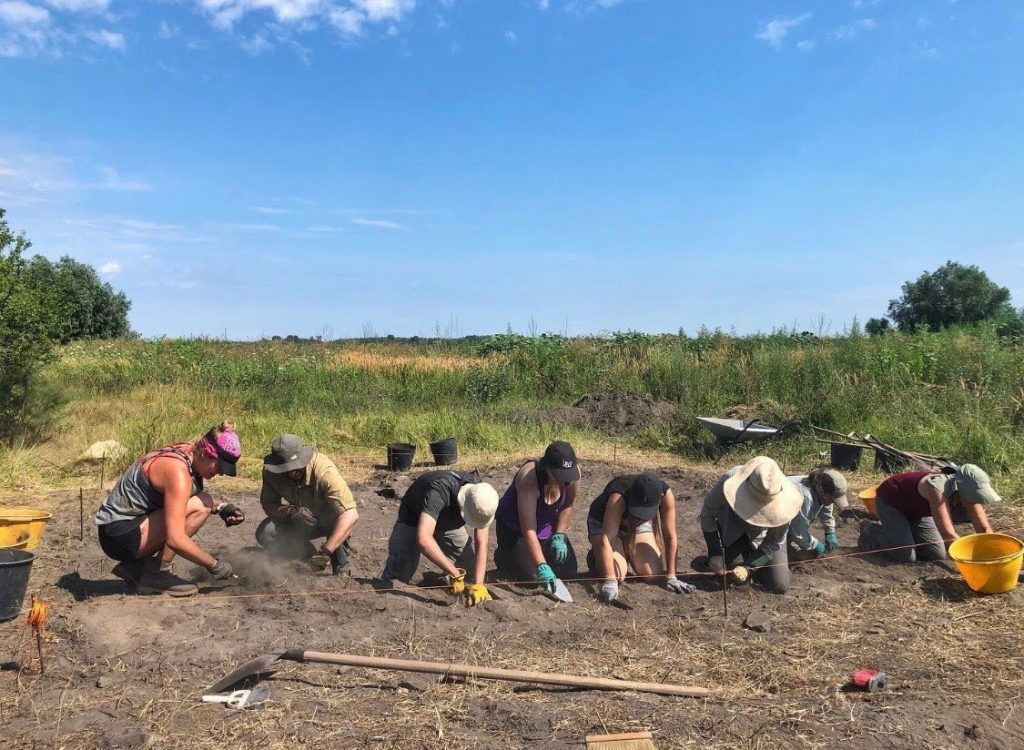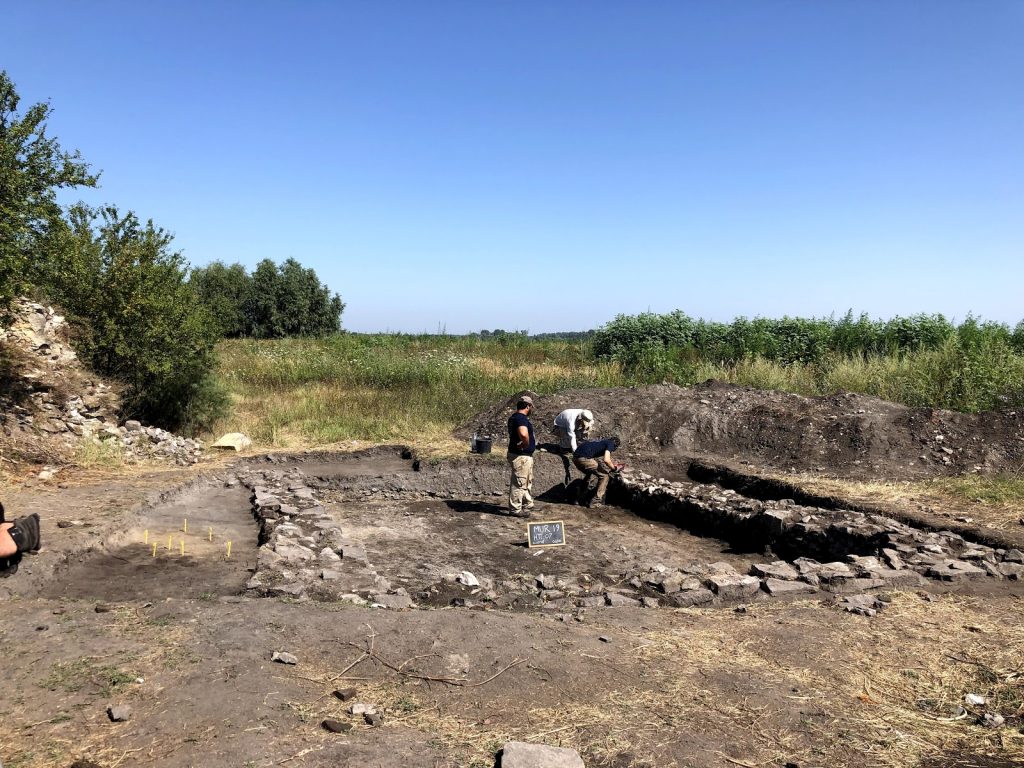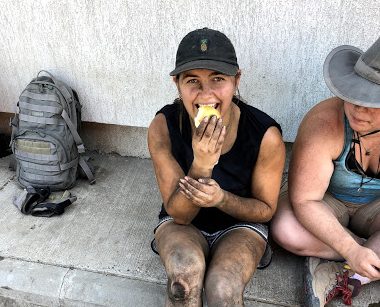The following article was originally written in March of last year by Bridget Roddy, class of 2020, regarding her Theory to Practice grant and trip the Halmyris archaeology site in Romania in 2019.
Halmyris is both a Greek word meaning “salt water” and the name of the ancient Roman fort that lies about four hours away from Bucharest, the capital of Romania. Situated along the Danube river, on what used to be part of the frontier of the Roman Empire, this site was where I spent a month over the summer of 2019 volunteering by engaging in archaeological field work which quickly became one of the best experiences of my life.
The area Halmyris rests upon was originally occupied by Getic tribes and influenced by Greek traders. The Getae may have built a fortified settlement there and it is speculated that the Greeks may have built a trading post before the Roman fort of Halmyris was constructed. Halmyris eventually came under Roman control during the early first century CE and construction of a fort began later in that same century. As a key point for traffic from those coming up from the Black Sea, this site was repeatedly attacked by different populations, mainly the Goths, the Germans, and even the Huns. Thus, the fort was reoccupied and rebuilt until the early seventh century CE when the Byzantine troops stationed at Halmyris, under Heraclius in the Eastern Roman Empire, were withdrawn to support a Persian war. It is probable that, without troops, the locals were eventually forced to abandon the once great Roman legionary fortress, as they were left in too vulnerable of a state to defend themselves. Continuous attacks by foreigners and its loss of importance to the Roman Empire were the key factors in Halmyris’s eventual decline. Halmyris’s visible features today include its unique trapezoidal shape, different towers around the fort, a bathhouse, walls, gates, and its military buildings and barracks. I was also able to visit the basilica where several dig seasons (or excavation/field seasons, depending on the dig site, vary between a couple of weeks to several months probably according to sponsors and team leaders goals for the site) ago they found the bodies of two Romanian, martyred, Christian saints (Epictetus and Astion). The basilica where the two saints rest is a popular site for pilgrimages and tourism.
In 2012 a ground penetrating radar (GPR) scan outside the walls of the fort of Halmyris revealed a three walled structure. This dig season the supervisors decided to assign me to this test trench along with other volunteers, while other groups scattered around the fort itself. It became known as the “Harbor Trench” because we were roughly in the location of where the shores of the Danube river would have been during the occupation of Halmyris. As time has passed, the river has moved further away from the site itself, allowing us to dig in the area where a structure once stood close to the fort’s walls. We began by weeding a 4×6 meter area, clearing away all plants to reveal the topsoil underneath. We then used pickaxes and shovels to clear away the topsoil as we kept an eye out for changes in soil composition, color, and textures in order to identify the different contexts. Contexts are “each action that leaves a trace in the stratification of an archaeological site” (from our excavation guide). When doing archaeological field work, one labels contexts in the order in which they are found. For example, as we were digging down from the topsoil layer, the wall of stones that we struck was the first change we encountered and was thus labeled as context 1. When the soil began to shift from loose, darker dirt to a lighter and more compact layer, we labeled that context 2. We knew we had reached a wall and not just a collection of collapsed stones, because there were three stones side-by-side and about level, meaning there was a high chance that it was a wall. As we continued to excavate, more and more stones began to form the wall both sideways and below, as well as creating a corner to another wall. So it was confirmed that we had indeed found a wall and the other connecting wall. The third and final wall was discovered, and more contexts were labeled both on top of the walls, inside the structure, and outside of the structure. This led to the layers inside the structure being made up of the topsoil, context 2, context 5, and finally context 7. Our structure that laid east to west, began to take shape within our trench.
Our structure’s three walls were in varying conditions. The one in the best condition had several layers of coursing, or how “the pattern of how the masonry fits together” (from our excavation guide). Another wall looked good in the corner but the construction technique seemed to change to smaller and more cobble stones as it continued onward. The last was still covered by the balk because we had not been able to uncover it completely due to time constraints and fear of undercutting (in this case it means to cut below a balk/vertical ninety degree section or wall showing stratigraphy, deep enough to cause it to collapse), but it did show that there were one or two coursing layers. My trench supervisor wondered whether or not we were looking at a better phase with two lesser phases on each side.

I worked every weekday clearing out the trench or expanding it by pickaxing context after context, articulating the balks, and brushing down every part of the trench at the end of the day so that pictures could be taken to record our work and progress, especially on the stratigraphy visible on the sides of the trench. I was also triangulating small or special finds, sifting and moving buckets to the dirt heap that we would in the end eventually have to shovel over even more so as to extend the trench, gathering up bags of ceramic, bone, and metal, and even working on pottery cleaning, all so that the secrets of Halmyris could be uncovered and brought to light once again from their hidden resting places.
The work we were doing taught me how to find where to set up trenches, and how to use rebar, string, tape measures, and levelers to outline the space we would be excavating. I learned about how to determine contexts, what artifacts we needed to look out for, proper methods for cutting down balks and articulating walls so as not to undercut them and have them collapse, and proper use of trowels, brushes, and hand axes. I learned about recording our finds and their locations, while also gaining experience by working on cleaning pottery. I was taught to look out for certain things in the soil: bronze coins that now appear green, or glass slag that could be mistaken for a rock if not for its subtle shine. Pottery was usually a reddish-orange and easy to pick out against the brown soil, metal was chunky and a deeper red, ancient glass was thin and sometimes had a flaky and shimmery covering, and animal bones (typically fish or small mammals, but one deer bone was uncovered as well) were usually a shade of brown, but sometimes could be discolored to a shade of green. I was seeking to learn about the practical skills it took to be an archaeologist and came out knowing way more than I bargained for!

My trench-mates and I were constantly questioning and wondering what the purpose of our structure we had uncovered in the trench had been. Our head supervisor proposed that it could be some type of ship shed, a meeting point of sorts. However, the topsoil that immediately started yielding finds, including our first coins, was probably the fill above the floor, which would have given us a better indication of the structure’s function. It was eroded away, the floor being the compact layer of context 5 between 7 and 2, with the topsoil above 2, as well. Therefore, an exact identification could not be completely ascertained.
Sediment was probably washed in from the Danube tributary which gave our harbor trench our most productive layer, context 7, with over fourty coins, an Isis figurine, bronze fragments, and much more. The coins and figurine were dated to the mid-fourth century, although since some coins have not been dated yet, we are left to question why we did not uncover more of a variation of finds from perhaps earlier dates if the tributary was constantly washing things in. The coins that have been dated along with the figurines create a concentration of dates that provide us with a terminus post quem, or time after which. Based on the floor and the coin finds, we can say that the sedimentary layer of context 7 was probably formed sometime in the fourth century and then afterward the structure was probably built sometime in the fifth or sixth century, possibly contemporaneous with the Justinian entrance also present at the site.
While excavating the entire site of Halmyris, it was common to find tons of pottery sherds (also known as potsherds), tiles, ceramic building material (CBM), bone, metal fragments, and glass shards, depending on where one was digging. Small or special finds we discovered this season that had their locations recorded were stamped pottery, inscribed building material, oil lamp pieces, fish weights, amphorae pieces, sling bullets, projectile points, knife fragments, beads, a carved bone hairpin or writing utensil (not yet determined what it was), nails, and glass slag. This season we also had some incredible finds from all over the site, such as an inscription, about fifty coins, incredibly well-preserved bronze brooches as well as other unidentifiable pieces of metal in worked shapes, an almost fully intact dolium, a tiny piece of gold, a deer skeleton left in situ, and two bronze figurines, one believed to be Isis and the other to be Osiris! My favorite experience from this dig was finding more coins than anyone else. In past dig seasons uncovering two or three coins from the entire site is common, however, I left having personally found seventeen in the harbor trench alone, including several follis Roman coins, categorized as such due to their large size. This was a very productive season at Halmyris, and the supervisors and I were overjoyed at the rare and extraordinary finds!
In the past, I have also visited the Roman fortresses of Enisala, Histria, and Salsovia while in Romania, and I have also been to the fort of Vindolanda in Northern England, as well as the Roman town of Corbridge. It is interesting to note that an inscription with the fort’s name at Salsovia has been found on the site itself. Despite the several inscriptions found at Halmyris, there has never been one uncovered that states the site’s name. Halmyris’s name is known from references in documents, yet proof from the site itself has never been unearthed.

Starting out from the first day just weeding away bits of grass and stumbling on shards of glass, to by the end uncovering coins galore, and jumping in and out of a pit up to my waist at times, showed me that what I had done had made a difference at this site. Together with my team, we had unearthed countless ancient artifacts, discovered new parts of the inside of the fort, and literally dug a pit to find an unknown structure. The Theory to Practice Grant experience allowed me to discover new abilities and learn about a field that I had always been curious about but never had the resources to explore. I was also able to meet some incredibly intelligent members of the archaeological field, and it was an honor to be working alongside them. Three years ago, when I came to OWU, never in a million years did I think I was going to be able to travel to Romania to do archaeological field work. It was truly an honor to represent my university on an expedition that took me across the globe! Visiting and excavating are two very different things, so I highly recommend giving archaeology a try!